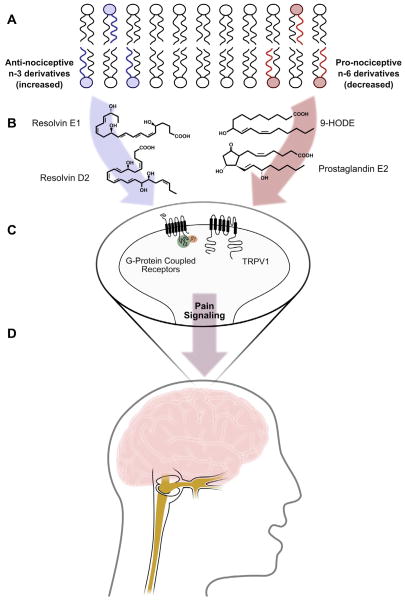Fig. 1.
Proposed mechanisms linking targeted alterations in n-3 and n-6 fatty acids with pain reduction. This figure summarizes hypothetical mechanisms linking n-3 and n-6 fatty acids to pain reduction, including representative mediators measured in the present trial (9-HODE and Resolvin D2) as well as mediators that were not measured in this trial (Prostaglandin E2 and Resolvin E1). (A) Targeted dietary alterations increase the abundance of n-3 EPA and DHA (blue) and decrease the abundance of n-6 LA and AA (red) in fatty acid precursor pools, including the membranes of endothelial cells, platelets, immune cells, glia, myelin, and neurons. (B) These changes in precursor abundance alter the concentrations of n-3 and n-6 derived antinociceptive and pronociceptive mediators, including E- and D-series resolvins, maresins, prostaglandins, endovanilloids, and endocannabinoids. (C) Changes in the milieu of lipid mediators alter the activities of receptors involved in pain signaling, including the vanilloid receptor (TRPV1) and several G-protein coupled receptors (eg, E-prostanoid receptors, resolvin receptors, cannabinoid receptors). (D) Increases in antinociceptive mediators and decreases in pronociceptive mediators reduce pain signaling in the trigeminovascular system and central pain signaling pathways. EPA, eicosapentaenoic acid; DHA, docosahexaenoic acid; LA, linoleic acid; AA, arachidonic acid; 9-HODE, 9-hydroxy-octadecadienoic acid.

